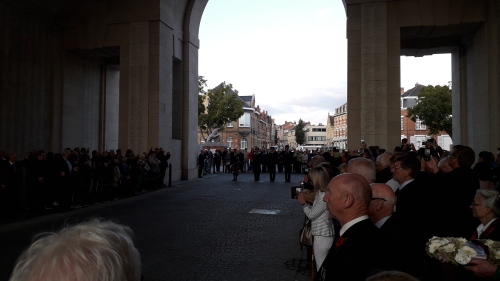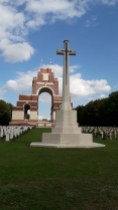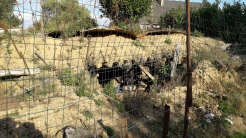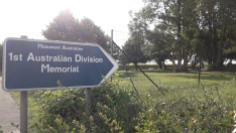The Clan Chisholm Society organised an International Gathering in Ieper (Ypres) in September of this year (2019), to commemorate Chisholms who had fallen in the Great War (1914-1918).
Our party stayed at the beautiful Ariane hotel, Slachthuisstraat 58, in 8900, Ieper (Ypres), www.ariane.be ph. +32 (0) 57 218 218, e: info@hotelariane.be.
Slachthuisstraat, “Slaughter Street” is just off de Oude Veemarkt (the old Cattle Market), a short and pretty direct walk from the Grote Markt.
They are very proud of their beef in Ieper which features prominently on the menus of the many excellent eating houses. One very popular and absolutely delicious dish that you will find on many menus in Ieper is Vlaamse Stoverij met Salade en Frietje “Flemish Stew with Salad and Chips”.
In the hotel the floors are strewn with the skins of cattle, some small chairs are also covered in skins, and the comfy sofas are made of the most excellent quality hide.

Off the lobby of the hotel Ariane is a large display stand dedicated to “The Madonnas of Pervyse”: Mrs Elsie Knocker and Miss Mairi Chisholm of Chisholm (my late great aunt), whose extraordinary courage is still celebrated and honoured today, over one hundred years later.

Outside in the Hotel’s lovely garden & covered seating area, at the water’s side, is a statue of Mrs Knocker and Miss Chisholm, and their dog “Shot”. The statue is thanks to the extraordinary efforts of our tour guide, Stefaan Vandenbussche, founder of “1418tours.com” www.1418tours.com (website in progress as I type), and with Diane Atkinson, historian and author, whose book “Elsie & Mairi Go To War” has helped bring the story of these two remarkable women to a brand new audience and appreciation. The Clan Chisholm Society kept in close contact with Diane Atkinson and Stefaan Vandenbussche. Their fund-raising proposal was included in the Clan website in 2013. The appeal went out to members in the UK in January 2014. Donations came from UK Branch members via the Secretary of the Clan Chisholm Society, however a number of people made donations directly to the online banking IBAN which was included in the proposal on Diane’s website http://www.dianeatkinson.co.uk/statue-fund.html Donations also came in from overseas members of the Clan Chisholm Society around the world. There is a piece about the unveiling of the statue in Ieper, which includes lovely photographs, on the Clan website: http://www.clanchisholmsociety.org/public/ypres.php

On our first evening in Ieper, Stefaan took us outside to see the statue of Elsie & Mairi, telling us how the statue came about, and how funding was raised to commission sculptor Josiane Vanhoutte. Afterwards we made our way to The Menin Gate via The Grote Markt, and St. George’s Memorial Church (built 1927-1929 to commemorate the 500,000 British & Commonwealth troops who died fighting in the three battles of the Ypres Salient).

Every single night, since 1927, at 8pm, The Last Post has sounded at The Menin Gate, by the buglers of The Last Post Association, (save for the duration of the 2nd World War, when Ieper was under German occupation). Occasionally, this nightly ceremony is extended, allowing for choirs to join in, prayers or poems to be read, as well as the laying of commemorative wreaths.
The Clan Chisholm Society, represented by Susan Chisholm, Clan Secretary, her cousin Mairi Angela Foster and fellow clansman Robert Chisholm (representing the New Zealand branch) laid a wreath in commemoration of fallen Chisholms.
Afterwards, before returning to the hotel, we ate a beautiful dinner at the Hotel-Restaurant ‘t-Zweerd (“The Sword”), Grote Markt 2, in 8900, Ieper, ph.: +32 (0) 57 20 04 75 www.gasthof-tzweerd.be e: info@gasthof-tzweerd.be where I, along with others in our little group, tried the famous Vlaamse Stoverij “Flemish Stew”, which was absolutely delicious!
On the second day of our tour, after a hearty breakfast at the Hotel Ariane, we boarded our bus with Stefan and drove through Pervyse, seeing the site where the original “Cellar House” had stood, from the window. The house was completely demolished during the first world war, but the cellar, where Elsie and Mairi were based still survives. Unfortunately, it is impossible to see this because it is now a rebuilt private house and the owners, naturally, do not wish a troupe of “War Tourists” disturbing them!
We arrived at the “Trench of Death” and Museum at Diksmuide (Dixmude), address: Ijkerdijk 65, in 8600, Diksmuide. Tel: 032 (0) 51 50 53 44 e: dodengang.diksmuide@warheritage.be and explored the last remnant of the Belgian First World War trench system and interpretation centre which delivers information in four languages: Dutch, French, German and English. The sign outside the museum reflects this: Dodengang, Boyau de la Mort, Totengang and Trench of Death.
A short journey took us back into Dixmude town, where we drove past the colossal Ijzertoren “the Yser Tower”, which commemorates the Flemish soldiers who were killed on the Yser (Ijzer) front during the first world war. The first tower was erected in 1930, but was blown up in 1946. Several years later, the present, much larger tower was built. The beautiful Pax gate, which sits in front of the Ijzer tower, overlooks the water at Portus Dixmuda, and was erected from the ruins of the first tower.

We had a delicious lunch at Restaurant Sint-Jan (Saint John), opposite the Ijzer tower. Address: Bloemmolenkaai 1, in 8600, Diksmuide, Belgium. www.st-jan.be e: info@st-jan.be Ph: +32 (0) 51 50 02 74. The dish we enjoyed at Sint-Jan was Vispannetje (roughly translated as fish pan), a sort of seafood chowder with a creamy gratin topping, served with the inevitable frietje (chips!)
After lunch we went to Passchendaele (Passendale), a village in the Ypres (Ieper) Salient*, within municipality of Zonnebeke, with an estimated population of just under 3,000. The Battle of Passendaele, also referred to as “The Third Battle of Ypres” (Derde slag om Vlaanderen), claimed the lives of over ½ a million soldiers (Allies as well as German).
In the heaviest rain for more than 30 years, the Ypres Salient became a quagmire; shell holes immediately became swamps. Many men, horses and pack mules drowned. 90,000 bodies have never been identified. 42,000 have never been recovered.
*Salient; the meaning is the same as “bulge” and is a military term for a battleground.
We visited the Tyne Cot Cemetery, Memorial and Visitor Centre, a little under 3km from Passendaele village.
Tyne Cot Memorial (built of Portland Stone brought from the Isle of Portland, off the coast of Dorset), and flint, which came from England as well as Italy! (Michael Davis, Trainee Archivist with the Commonwealth War Graves Commission very kindly researched the origins of the flint for me!) It bears the names of 35,000 servicemen from the U.K. and New Zealand, for whom there is no known grave.
In Tyne Cot Cemetery lie the remains of 12,000 servicemen. 8,300 of these are “Known Unto God” as their headstone says, and remain unidentified.
Here the Clan Chisholm Society laid a wreath representing the UK Branch.
Our party then went a short distance to Polygon Wood and Buttes New British Military Cemetery. The Society laid a wreath, representing the Australian Branch of the Clan Chisholm Society, at the foot of the Australian Memorial, an impressive 40ft obelisk, which looks out over the cemetery from the butte. The Australian Memorial is dedicated to the 5th Division.
There is both a Stone of Remembrance and a Cross of Sacrifice here at Polygon Wood.
Afterwards, we made our way down to the New Zealand Memorial, where the names of 378 men are carved into the structure. In between the elegant stone pillars, the Australian Memorial, which sits atop the butte is beautifully framed. Here the Clan Chisholm Society laid a wreath representing the New Zealand Branch of the society.
Next, our group went to St. Julian, Canadian Memorial, known as “The Brooding Soldier”. The monument commemorates Canadians who fought in the Second Battle of Ypres. On 22nd April 1915, the Germans released 180,000 kilos of chlorine gas. There were approximately 6000 casualties in the first ten minutes. Around 2000 died. Many more were blinded.

Two or three km away, we visited Poelcapelle British Cemetery. Here are buried almost seven and a half thousand servicemen, of which 6,230 of them are unknown.

Of all the Commonwealth Graves, by far the most moving, and most visited, is that which belongs to Private John Condon, 2nd Battalion of the Royal Irish Regiment. John was only 13 when he travelled to Tipperary from his native Waterford to enlist. It is hard to believe that the medic who examined him and the recruiting officers didn’t recognise his stated age as being false. This motherless boy died on Monday 24th May 1915, aged just 14. There are more crosses, poppies and flowers, as well as other little mementoes, including coins left on this tragic grave than on any other. That there survives a photograph of this child only serves to break one’s heart more completely. Ar dheis Dé go raibh a anam dílis.
We headed back to the hotel Ariane in rather sombre mood.
Later we had a talk and screen representation by Stefaan on Elsie and Mairi and enjoyed a beautiful dinner.
Day Three
We set off after breakfast and headed to France! By half past ten we had arrived at the Canadian National Vimy Memorial.
Our guide showed us to the Canadian trench, where we climbed down inside and made our way along well-lit tunnels. We were reminded that these would have been in darkness. When we again emerged into the daylight, she pointed out the humps and hollows made by the shelling, and just how close to us was the German trench. The whole area is still full of unexploded shells which prevents the caretakers from mowing the grass, and it is for this reason that sheep are kept on the grounds to mow the grass (and we hope NOT detonate any buried explosives!)
If you follow these three photos 1,2 & 3, you can see just how close the two sides were: 1: Canadians, 2: Mid Ground, 3: Germans! Only yards away!



The weather could not have been more perfect for our visit; the blue sky without a single cloud, against which the twin pylons (one representing France with the fleur-de-lis, the other Canada with the maple leaf) shone in dazzling white stone.
Designed by award-winning sculptor Walter Allward (1875-1955), the significance and meanings of many of the carved figures eludes me somewhat! There are obviously religious references (Faith, Hope & Charity), the inspiration for many of the carvings must have been Michelangelo (the 16th century Medici tomb in Florence), and Rodin.
Other carvings include Honour, Justice, Knowledge, Peace & Truth.
The first two that visitors are greeted with are called The Mourners: a semi naked female depicted reading the Roll of Honour and male holding a drooping laurel branch.
Canada Bereft is depicted as the Mater Dolorosa (Our Lady of Sorrows). She stands, alone, staring into the empty tomb, mourning her great loss.
The Society laid a wreath representing the Canadian Branch of the Clan Chisholm Society.
We sat outside the centre, in absolutely boiling weather and ate our welcome picnic before getting back onto the coach.
Our next stop was Thiepval.
The Thiepval Memorial was designed by Sir Edwin Landseer Lutyens 1869-1944. It is the largest of all the Commonwealth memorials and stands on the site of the most heavily defended German positions to be attacked on July 1st, the first day of the Battle of the Somme, when Commonwealth casualties (Killed, Wounded or Missing) numbered more than 60,000!
The Thiepval Anglo-French Cemetery, which symbolises the Allied effort of War, contains the graves of 300 French soldiers and 300 Commonwealth soldiers. The majority of them are unidentified.
The Thiepval Memorial is about 150 feet in height, and the foundations are thirty feet deep. It is an absolute colossus. Built in red brick and Portland stone it is a magnificent edifice. No postcard or photograph prepares one for the sheer size of this monument which dwarves all around it.
Back on the coach for a short journey to Pozieres. Our party went straight into Restaurant and Museum le Tommy. Address: “Le Tommy”, 91 Route d’Albert, in 80300, Pozieres, France. www.letommy1916.com ph.: +33 3 22 74 82 84. Le Tommy is a remarkable place, the inspiration of Proprietor Dominique Zanardi. His museum, which includes a recreation of the trenches that are so lifelike it brings home to one the true horrors of living in these hellish conditions. Along one side can be seen the Allied soldiers, (Australians?) going about their daily business, making tea, cleaning weapons, whilst a stone’s throw away on the opposite side, the enemy, the German soldiers, go about theirs. Despite the fine weather, it was not hard to imagine just how awful this existence would be in sustained wet conditions.
A short walk up the street from le Tommy is the Pozieres Memorial and Cemetery, which honours the First Australian Division. In seven weeks of fighting, the Australian Divisions sustained 23,000 casualties, including almost 7,000 either killed outright or who died of their injuries.
Day Four
We were scheduled to join the tour and visit the Commonwealth Cemetery “Lyssenhoek” in Poperinge, and then go onto the American “Flanders Fields” Cemetery in Waregem, but I felt that I should really much prefer to spend the morning in Ieper.
It seems a little sad to me that Ieper (Ypres) has been consumed by “War Tourism”. They are such an obliging, friendly people, still so respectful and grateful to the Allied effort to free their country from the enemy occupation that had destroyed their ancient town. I felt I owed it to the people of Flanders to learn something of their own long and interesting history, and I was delighted that I had this brief opportunity to do so.
We visited the museum, both the inevitable “Flanders Fields” museum, but also the vastly more intriguing museum, with its mysterious Cat Throwing tradition running throughout many the exhibits; designed to amuse and delight younger visitors.
The town of Ieper (Ypres) was (like many towns in East Anglia), built on wool. Wool was brought to Ieper from England and there it was turned into the finest cloth. The Flanders Fields museum is located in the beautiful Cloth Hall (Lakenhalle).
In 1200, Baldwin IX, Count of Flanders and Emperor of Constantinople (Istanbul), laid the foundation stone of The Lakenhalle (Cloth Hall). It would take a hundred more years to finish. The Belfry (Clock Tower) is 230 feet in height and can be climbed from within the museum. The view from there is absolutely staggering. You can see all of Ieper and the surrounding landscape from up there.
The 49 bell carillon chimes hourly throughout the day: https://youtu.be/6-FwhEQ5TXY
Next door to the Lakenhalle is the Cathedral (now downgraded to church) of St. Martin. The building was started in 1221, on the banks of the river up which ships carrying wool from England sailed to dock by the Cloth Hall, and is built on the site of an earlier church. The present spire, higher than its original, now reaches 328 feet in height. St. Martin (316-397) as well as being the Patron Saint of neighbouring France, is also the Patron Saint of Wool Weavers. His most famous icon depicts him halving his woven cloak with his sword in order to clothe an almost naked beggar in Amiens.
The wool, which had arrived from England, was stored in the Cloth Hall, until it was bought by artisan spinners and weavers and turned into cloth. The cloth was then returned to the Cloth Hall, where it remained until the annual fair.
Legend has it that the Cloth Hall was overrun with mice who were nesting in and chewing holes in the precious cloth. Someone had the bright idea of bringing in cats to kill the mice. The cats then reproduced until they became a worse problem for the people of Ieper. It became a tradition to throw the live cats from the belfry on Ascension Thursday (forty days after Easter), but was later brought forward to the second week of Lent. In modern times, the Festival is no longer an annual event, and is now held every three years, on the second Sunday in May, where a jester throws a stuffed toy cat from the belfry. It forms part of a Parade of The Cats, which honours the much-maligned creature. It must be noted that during medieval times, the cat was often seen as the physical manifestation of evil, associated with witchcraft, which may also have contributed to its persecution. The last live cat to have been thrown from the belfry is recorded by diarist Jean Jacques Lambin, as having happened in 1817, where he writes that the cat survived the fall: “..the little animal scampered as fast as it could..”
Without doubt, the most remarkable thing about Ieper is the spirit of her people. Photographs taken before the bombardment of the Great War, show the town has been rebuilt almost exactly as it was. The people of Ieper were able to identify their own properties and it was collectively agreed that each building would be rebuilt exactly as it was before. They lived in temporary wooden huts at their respective sites while this massive task was undertaken; digging and sifting through rubble to reclaim stone and bricks. Both the Cathedral and the Cloth Hall were built again from salvaged materials, using original plans, with minor alterations (such as the higher steeple of St. Martins). Some of the broken artefacts are still strewn around beside the Cathedral; pieces of pillars and carved stone, and the Angels, badly damaged, which once adorned the high walls, now form a little semi-circle inside the Cathedral.
To look at the buildings, you would never guess that they were less than one hundred years old. Many of the familiar buildings owe their architectural style to the French designers of the Middle Ages, and are absolutely beautiful.
































































